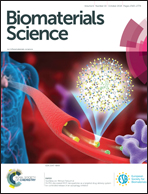Primary tumor and pre-metastatic niches co-targeting “peptides-lego” hybrid hydroxyapatite nanoparticles for metastatic breast cancer treatment†
Abstract
Both tumor metastasis resisting therapy (TMRT) and tumor metastasis targeting therapy (TMTT) attempt to improve tumor metastasis treatment, but they are limited by dynamic metastatic escape or insufficient micrometastases drug accumulation, respectively. Doxorubicin (DOX)-loaded functional peptide combination (PMC)-modified hydroxyapatite (HP) multi-mode nanoparticles (DPH) were developed to realize tumor metastasis amphibious therapy by balancing TMRT and TMTT. An in vivo imaging study showed that DPH had efficient drug delivery ability targeting to primary tumor and micrometastasis. Besides, it was found that cathepsin B-triggered intracellular mitochondria and nuclei dual-targeted treatment could enhance the antitumor effect of DOX by a synergistic effect. DPH treatment finally achieved both primary tumor and micrometastases reduction in 4T1 aggressive lung metastasis models. The tumor metastasis inhibition of DPH was attributed to blocking the mitochondrial escape signaling pathways. The results also showed the enhanced anticancer benefits of DPH, which could orchestrate TMRT and TMTT in contrast to a mixture of DOX and PH (PMC-modified HP nanoparticles). Overall, we generated multi-mode nanoparticles that could flexibly realize amphibious therapy for metastatic cancer while reducing systemic drug exposure and off-target toxicities.



 Please wait while we load your content...
Please wait while we load your content...